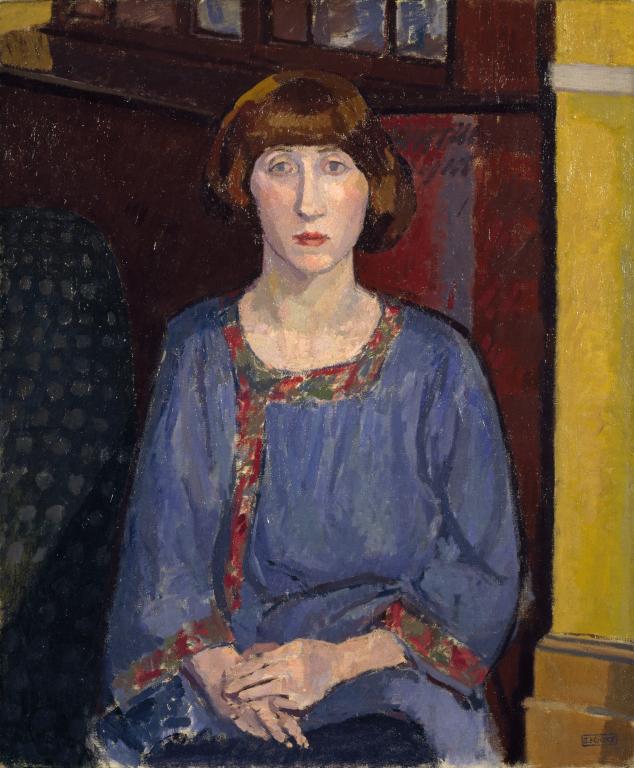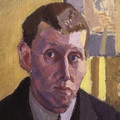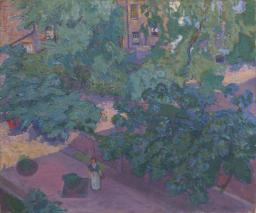Spencer Gore The Artist's Wife 1913
Spencer Gore,
The Artist's Wife
1913
Spencer Gore’s wife Mollie trained as a dancer in Edinburgh. Gore shows her seated on the floor of their first flat together at 2 Houghton Place in north London, leaning against a cabinet. The dense colour of the walls and background furnishings emphasise her informally rendered figure, which is given strong shape by her bobbed hairstyle and tunic dress then fashionable in bohemian circles.
Spencer Gore 1878–1914
The Artist’s Wife
1913
Oil paint on canvas
765 x 636 mm
Inscribed by Harold Gilman ‘Portrait of Mrs S.F. Gore. | Painted by S.F. Gore at 2 Houghton Place. | N.W. in 1913. unsigned | (171) (a)’ on label on back; studio stamp ‘S.F. GORE’ bottom right.
Presented by the artist’s son Frederick Gore 1983
T03561
1913
Oil paint on canvas
765 x 636 mm
Inscribed by Harold Gilman ‘Portrait of Mrs S.F. Gore. | Painted by S.F. Gore at 2 Houghton Place. | N.W. in 1913. unsigned | (171) (a)’ on label on back; studio stamp ‘S.F. GORE’ bottom right.
Presented by the artist’s son Frederick Gore 1983
T03561
Ownership history
Mrs Mary Johanna Gore, the artist’s widow; by descent to their son Frederick Gore, by whom presented to Tate Gallery 1983.
Exhibition history
1970
Spencer Gore 1878–1914, The Minories, Colchester, March–April 1970, Ashmolean Museum, Oxford, April 1970, Graves Art Gallery, Sheffield, May–June 1970 (60, reproduced).
1996–7
Spencer Gore in Richmond, Museum of Richmond, September 1996–January 1997 (no number, reproduced p.21).
2008
Modern Painters: The Camden Town Group, Tate Britain, February–May 2008 (49, reproduced).
References
1974
John Woodeson, ‘Spencer Gore’, Connoisseur, vol.185, no.745, March 1974, reproduced fig.9.
1980
Simon Watney, English Post-Impressionism, London 1980, reproduced fig.106.
1984
‘Twentieth-Century Acquisitions at the Tate Gallery’, Burlington Magazine, vol.126, December 1984, p.810, reproduced p.811.
1986
Tate Gallery Acquisitions 1982–84, London 1986, p.189, reproduced.
2000
Wendy Baron, Perfect Moderns: A History of the Camden Town Group, Aldershot and Vermont 2000, p.182.
Technique and condition
The Artist’s Wife is painted in artists’ oil paints on primed stretched canvas. There is a paper label with a handwritten ink inscription on the back of the stretcher. It is consistent with others found on the back of Gore’s work, which were written and attached posthumously by Harold Gilman in 1914 (see also Tate T02260). The label reads: ‘Portrait of Mrs S.F. Gore. | Painted by S.F. Gore at 2 Houghton Place. | N.W. in 1913. unsigned | (171) (a).’ The canvas is made of a mixture of flax (linen) and hemp fibres and has a plain open weave. Sizing was applied to the cloth forming a minimal layer of animal glue. A double-white primer covering the extant of the canvas was evenly applied and retains the weave texture. The upper layer of the primer contains lithopone, which is also found in other paintings by Gore of this period (see also Tate T01960). The marks of the artists’ colourman Percy Young are stamped on the centre of the back of the canvas and on one of the stretcher bar members (see also Tate N05099). The primed canvas is stretched onto a four-member stretcher and retains its original attachment with steel tacks. The dimensions of the support match the standard commercial size, historically called ‘three-quarter size’, indicating that it was probably purchased pre-stretched.
The composition was freely sketched in paint without any visible preparatory drawing. What may have been the initial indication of the features in dark blue paint can just be glimpsed within the eyebrows and parting of the lips (see also Tate T02260). The portrait, although simplified in form and free of unnecessary detail, is intensively worked. Gore has built up several layers of paint, keeping each application of colour fresh and clean. Paint was applied in bodied mixtures that retain some brushmarking. In some areas the paint appears to have been thinned, probably with a dilutent before application. This allowed Gore to work briskly over large areas, which were then modified with strokes applied wet-in-wet. The assured working of the costume, furniture and walls form a lively backdrop for the intense painting of the portrait. The furniture and walls are rendered in dense colours that largely obliterate the white priming, while the reflections in the glazed cabinet, blue costume and hands incorporate broken passages of colour through which the priming is visible. The strong shape of the costume is defined with dark outlines during painting while the uncertain position of the hands remains unresolved. There are traces of varnish residue trapped in the texture of the paint.
Roy Perry
June 2004
How to cite
Roy Perry, 'Technique and Condition', June 2004, in Robert Upstone, ‘The Artist’s Wife 1913 by Spencer Gore’, catalogue entry, May 2009, in Helena Bonett, Ysanne Holt, Jennifer Mundy (eds.), The Camden Town Group in Context, Tate Research Publication, May 2012, https://wwwEntry
Gore married Mary Johanna Kerr, known as Mollie, in January 1912. They first met in 1911, possibly introduced by Gore’s friend the artist Albert Rutherston. Mollie came from Edinburgh where she trained as a dancer at the Opera, and also modelled for the painter Charles Hodge Mackie (1862–1920). In London she knew a number of artists and art students, possibly modelling for them, and through this circle met Rutherston and Gore.1 Gore painted her portrait several times both before and after they married. In 1911 he painted at least four: The Balustrade, Mornington Crescent (Leeds City Art Gallery),2 The Artist’s Wife (Birmingham City Art Gallery),3 Mrs S.F. Gore in the Garden of Rowlandson House (private collection)4 and The Artist’s Wife, Mornington Crescent (Te Papa Tongarewa Museum of New Zealand, Wellington).5 In 1913 he painted The Gas Cooker (Tate T00496), which shows Mollie at work in the kitchen of their first home together, a flat at 2 Houghton Place NW1.

Spencer Gore 1878–1914
Self-Portrait 1914
Oil paint on canvas
410 x 305 mm
National Portrait Gallery, London
Photo © National Portrait Gallery, London
Fig.1
Spencer Gore
Self-Portrait 1914
National Portrait Gallery, London
Photo © National Portrait Gallery, London
This portrait shows Mollie sitting on the floor of their living room at 2 Houghton Place, her back against a glass-fronted bookcase or cabinet. Her pose is relaxed, but her gaze direct and arresting. The dress she is wearing would have been considered avant-garde at the time. It is a side-fastening, thigh-length tunic based on Russian costume, which became fashionable in artistic and bohemian circles through the popularity of Diaghilev’s Ballets Russes, who first performed in London in 1911. Her bobbed haircut would also have been considered advanced and daring. The bob was popularised in Britain by the American dancer Irene Castle (1893–1969) around 1914, but young women in artistic circles were having their hair cut like this slightly before. The artist and model Nina Hamnet (1890–1956), for instance, had her hair cut into a bob in 1913 by the sculptor Ossip Zadkine (1890–1967) so that she resembled one of his statues.9
Gilman inscribed a label in ink on the reverse ‘Portrait of Mrs S.F. Gore. | Painted by S.F. Gore at 2 Houghton | Place. N.W. in 1913. unsigned | (171) (a)’.
Robert Upstone
May 2009
Notes
Reproduced in Spencer Frederick Gore 1878–1914, exhibition catalogue, Anthony d’Offay Gallery, London 1983 (13).
Reproduced in The Painters of Camden Town 1905–1920, exhibition catalogue, Christie’s, London 1988 (6).
Information from Valerie Mendes, Curator of Textiles & Dress, Victoria and Albert Museum. For more on this, see Meaghan Clarke, ‘Sex and the City: The Metropolitan New Woman’, The Camden Town Group, Tate 2011, http://www.tate.org.uk .
Related biographies
Related essays
- Her Indoors: Women Artists and Depictions of the Domestic Interior Nicola Moorby
- London’s Fashion Culture and the Camden Town Group Painters Christopher Breward
- From Drawing Room to Scullery: Reading the Domestic Interior in the Paintings of Walter Sickert and the Camden Town Group Juliet Kinchin
- Sex and the City: The Metropolitan New Woman Meaghan Clarke
Related catalogue entries
How to cite
Robert Upstone, ‘The Artist’s Wife 1913 by Spencer Gore’, catalogue entry, May 2009, in Helena Bonett, Ysanne Holt, Jennifer Mundy (eds.), The Camden Town Group in Context, Tate Research Publication, May 2012, https://www



